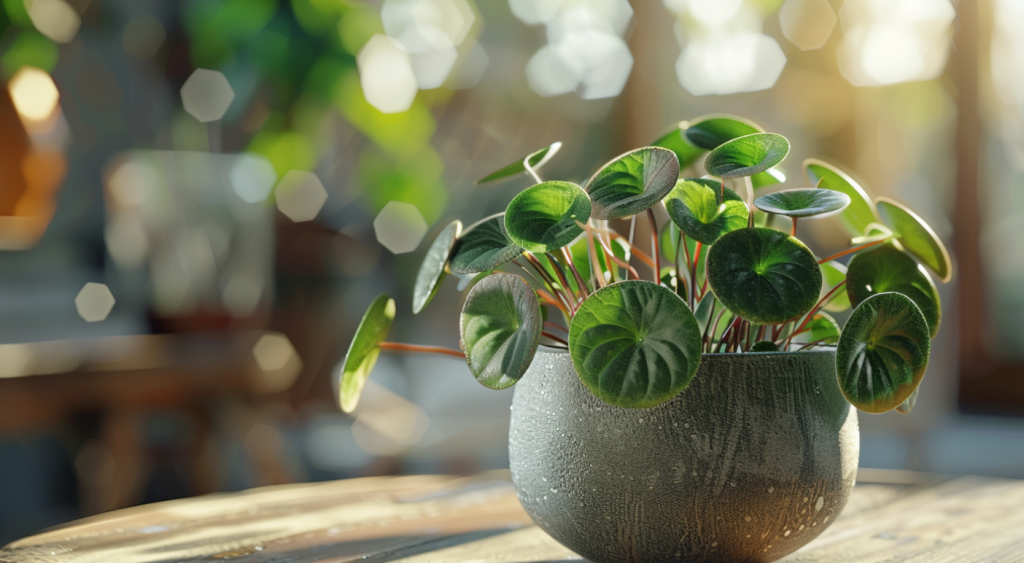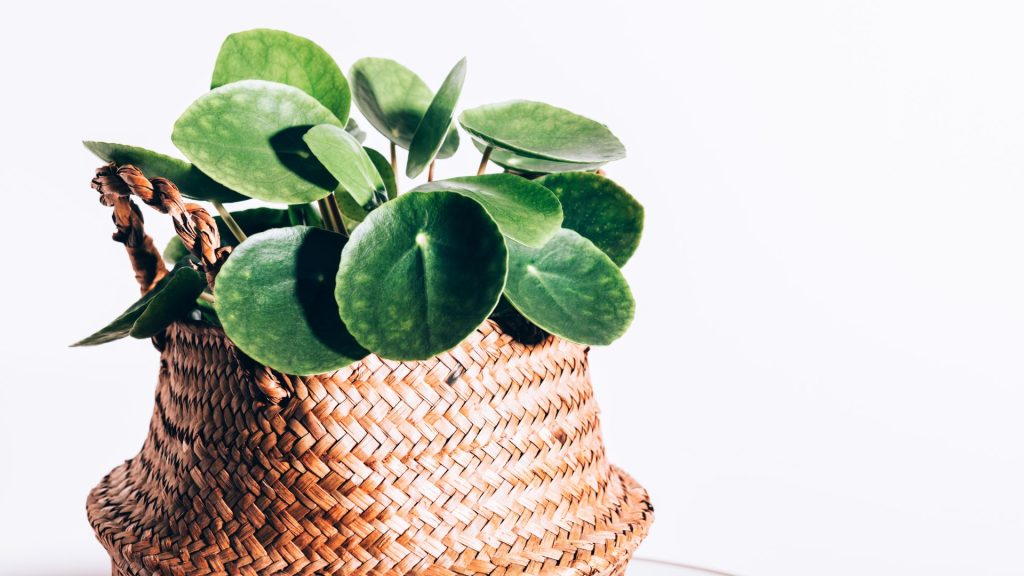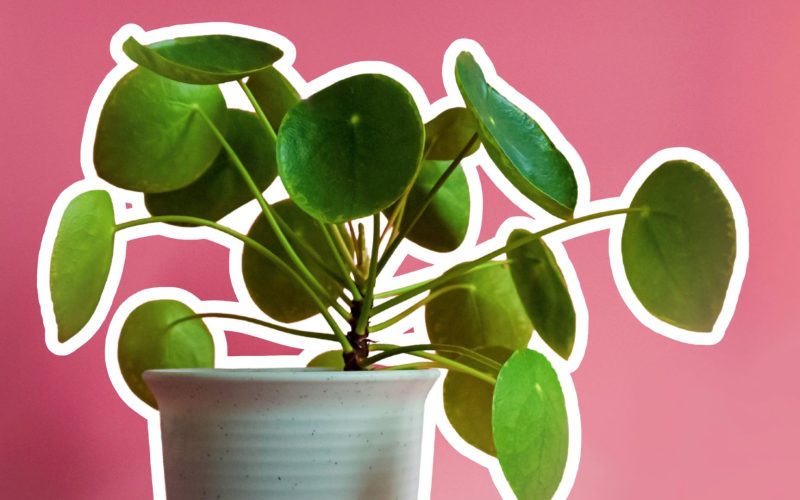Growing houseplants can be tricky, especially when dealing with a unique species like the Chinese Money Plant.
Many plant lovers find themselves struggling to keep these charming plants thriving.
Don’t worry—we’ve got you covered. This guide will share tried-and-true tips for growing healthy, happy Chinese Money Plants.
You’ll learn everything from proper light and water needs to propagation techniques.
Get ready to discover the secrets of Pilea peperomioides care.
We’ll explore its fascinating history, key characteristics, and why it’s become such a beloved houseplant.
By the end, you’ll have all the knowledge you need to grow your thriving Chinese Money Plant.
Overview of Chinese Money Plant

Let’s introduce ourselves to the “Pilea peperomioides.” You might know it by its more colorful names: Chinese Money Plant, Pancake Plant, or UFO Plant.
These nicknames all stem from their unique appearance, which we’ll get into in a moment.
This little green wonder has an interesting backstory.
It’s originally from southern China, growing naturally at the base of the Himalayan mountains.
But here’s where it gets fun – the plant made its way to the rest of the world in a rather unconventional manner.
In the 1940s, a Norwegian missionary named Agnar Espegren brought some cuttings home.
He shared them with friends and family, and soon, these plants were growing all over Scandinavia. From there, they spread to the rest of the world.
Key Characteristics and Appeal: Chinese Money Plant
Now, what makes this plant so special? Well, it’s all about those leaves.
- The Chinese Money Plant has these perfectly round, coin-shaped leaves that seem to balance on thin stems.
- It’s like nature created a plant version of a modern art sculpture.
- This unique look makes it a real eye-catcher in any room.
- But its appeal goes beyond looks.
- One of the reasons I love this plant (and why so many others do, too) is that it’s relatively easy to care for; you don’t need to be a plant expert to keep a Chinese Money Plant happy.
- Plus, it’s a champion when it comes to propagation.
- A healthy plant will produce lots of little “pups” or offshoots, which you can separate to create new plants.
- That’s why it’s sometimes called the “friendship plant” – it’s perfect for sharing with friends!
Essential Care for Chinese Money Plant

Growing a healthy Chinese Money Plant isn’t rocket science but requires some know-how. In this section, We’ll share tried-and-true tips for providing the right light, water, soil, temperature, and humidity to help your plant thrive.
Light Requirements
Regarding light, Chinese Money Plants are a bit like Goldilocks – they want it just right.
- These plants thrive in bright, indirect sunlight. Too little light, and they’ll become leggy and lose their vibrant color.
- Too much direct sun and those beautiful leaves can get scorched.
- We’ve found that the best spot for the Chinese Money Plant is near an east or west-facing window.
- This way, it gets plenty of light throughout the day, but it’s protected from the harsh midday sun.
- If you only have a south-facing window, you might want to use a sheer curtain to filter the light.
- Remember to rotate your plant every week or so. This helps it grow evenly and maintain that nice, symmetrical shape we all love.
Watering and Soil
Watering can be tricky with Chinese Money Plants, but here’s a simple rule you should follow:
- Wait until the top inch of soil feels dry before watering.
- These plants don’t like to sit in wet soil, so it’s better to underwater than overwater.
- When you do water, give it a good soak until water runs out of the drainage holes.
- Then, empty the saucer underneath – your plant will thank you for not letting its roots sit in water.
- As for soil, Chinese Money Plants prefer a well-draining mix.
- Regularly potting soil and mixing in some perlite to improve drainage helps prevent the soil from becoming waterlogged, which can lead to root rot.
Temperature and Humidity
Chinese Money Plants are pretty adaptable when it comes to temperature.
- They’re happiest in average room temperatures between 60°F to 75°F (15°C to 24°C).
- Keep them away from cold drafts or heating vents, which can stress the plant.
- While they can tolerate average household humidity, these plants appreciate more moisture in the air.
- If you notice the leaf edges turning brown, that might be a sign the air is too dry.
- To increase humidity, you can try a few things:
1. Group your plants – they create a more humid microclimate.
2. Place a water tray near the plant (not under it).
3. Use a small humidifier nearby.
Soil and Fertilization
Regarding soil, Chinese Money Plants aren’t too picky, but they have some preferences.
We’ve found that a well-draining potting mix works best.
Here’s a simple recipe to use:
- Mix regular potting soil with some peat moss and perlite.
- This combo provides good drainage while still retaining enough moisture.
- As for feeding your plant, less is often more.
- Fertilize the Chinese Money Plant monthly during spring and summer when it’s actively growing.
- Use a balanced, water-soluble fertilizer diluted to half-strength.
- Remember to hold off on fertilizing in fall and winter when growth slows down.
Pruning and Maintenance
Pruning isn’t usually necessary for Chinese Money Plants, but maintenance goes a long way.
If your plant looks slightly leggy or uneven, you can pinch off the growing tip to encourage bushier growth.
Don’t worry – new leaves will sprout from the sides of the stem.
Here’s a pro tip:
- Rotate your plant a quarter turn each week.
- This ensures all sides get equal light exposure, promoting even growth.
- Those pancake-like leaves tend to face toward the light source, so rotating helps maintain that nice, symmetrical shape.
- Speaking of leaves, they can collect dust over time.
- Gently wipe it down with a soft, damp cloth every few weeks.
- This keeps the plant looking fresh and helps it photosynthesize more efficiently.
- Lastly, don’t be alarmed if lower leaves yellow and drop off occasionally, this is normal, especially for older leaves.
- Just remove them to keep your plant looking tidy. With these simple care techniques, your Chinese Money Plant will stay healthy and attractive year-round.
Encouraging Blooming
We’ll let you in on a little secret – getting a Chinese Money Plant to bloom indoors is like finding a four-leaf clover.
It’s rare but not impossible!
When grown as houseplants, these plants don’t often flower, but it’s a treat when they do.
The tiny white flowers appear on thin stalks rising from the base of the plant.
To encourage blooming:
- Try giving your plant a bit of a winter chill.
- Move it to a cooler room (around 50-60°F) for a few weeks in winter.
- This mimics its natural habitat and might trick it into flowering.
Remember, your plant can still be perfectly healthy and happy even if you don’t see flowers.
Seasonal Care Adjustments
Like us, Chinese Money Plants appreciate a change of routine with the seasons.
- When the plant is actively growing in spring and summer, you should water more frequently and stick to my monthly fertilizing schedule.
- The longer days and warmer temperatures mean the plant uses more water and nutrients.
- Come fall and winter, you ease that up; growth slows down, so you should reduce watering and stop fertilizing altogether.
- Overwatering in winter can lead to root rot, so it’s better to err on the dry side.
- Also, move the plant from cold windows to protect it from drafts.
- If you live somewhere with harsh winters, you might need to increase humidity around your plant.
- Dry indoor heating can be tough on tropical plants.
- A small humidifier or pebble tray can help keep your Chinese Money Plant comfortable through the colder months.
Remember, these seasonal adjustments are about creating the best environment for your plant year-round.
You’re helping your Chinese Money Plant thrive through all seasons by mimicking its natural habitat changes.
Addressing Common Issues of Chinese Money Plant

Even the most well-cared-for Chinese Money Plants can face challenges from time to time. In this section, We’ll share some of the best experiences with common pests, diseases, and troubleshooting tips to help you keep your plant healthy and thriving.
1. Pests and Diseases
- Even though Chinese Money Plants are generally hardy, they can sometimes face unwelcome visitors.
- To our knowledge, the most common pests are spider mites and fungus gnats.
- Spider mites are tiny pests that can cause speckling on leaves.
- If you notice fine webbing between leaves, that’s a sure sign.
- We’ve found that regularly misting the leaves or wiping them with a damp cloth can discourage these critters.
- For more severe cases, use insecticidal soap.
- On the other hand, Fungus gnats are usually a sign of overwatering.
- These little flies love moist soil.
- The best prevention is to let the top layer of soil dry out between waterings.
- If you already have an infestation, try using sticky traps or watering with water and hydrogen peroxide.
Root rot is the main culprit when it comes to diseases. It’s almost always caused by overwatering or poor drainage.
To prevent this, I make sure my pots have drainage holes and never let the plant sit in water.
If you suspect root rot, it’s best to unpot the plant, trim away any mushy roots, and repot in fresh, well-draining soil.
2. Common Symptoms and Solutions
Sometimes, your Chinese Money Plant might try to tell you that something’s wrong.
Here are a few common symptoms you can encounter and how you should address them:
- Yellowing leaves: This often means overwatering. I check the soil moisture and adjust my watering schedule. Remember, it’s better to underwater than overwater.
- Drooping: If the plant is drooping but the soil is dry, it’s thirsty! Give it a good drink. If the soil is wet, you might be overwatering. I’d let the soil dry out more between waterings in this case.
- Leaf curl: Curling leaves can indicate too much or too little water. I check the soil moisture and adjust accordingly. It can also indicate low humidity, so I might increase misting or use a pebble tray.
- Brown leaf edges: This is often due to low humidity. I increase humidity around the plant or move it away from dry air sources like heaters.
Remember, the key to addressing these issues is observation and gradual adjustment. I always make one change at a time and wait to see how the plant responds. Your Chinese Money Plant will bounce back and thrive with patience and care.
Propagation Techniques of Chinese Money Plant
Propagating Chinese Money Plants is like getting free plants – fun and rewarding! In this section, I’ll share my tried-and-true methods for multiplying your plant family using offshoots and stem cuttings so you can spread the joy of these unique plants.
1. Propagation from Offshoots
One of the reasons people love Chinese Money Plants is how easily they propagate.
It’s like they’re eager to share the love!
The most common method is through offshoots, or “pups,” that grow from the mother plant’s base.
Here’s step-by-step guide:
- Wait until the offshoot is about 2-3 inches tall.
- Gently dig around the base of the offshoot to expose the roots.
- Using a clean, sharp knife, cut the offshoot away from the mother plant, including some roots.
- Plant the offshoot in a small pot with fresh, well-draining soil.
- Water lightly and place in a bright spot with indirect light.
Keep the soil lightly moist but not soggy for the newly propagated plants.
They prefer bright, indirect light, just like their parent.
Be patient—it might take a few weeks for new growth to appear. Before you know it, you’ll have a whole family of Chinese Money Plants!
2. Propagation from Stem Cuttings
While offshoot propagation is more common, you can also propagate Chinese Money Plants from stem cuttings.
This method is great if your plant has grown tall and leggy. Here’s how you can do it:
- Choose a healthy stem with at least two leaves.
- Using clean scissors, cut the stem just below a leaf node.
- Remove the lower leaves, leaving just the top one or two.
- Place the cutting in a glass of water, ensuring no leaves are submerged.
- Put the glass in a bright spot with indirect light.
- Change the water every few days to keep it fresh.
In about 2-3 weeks, you should see roots developing.
Once the roots are about an inch long, it’s time to plant the cutting in soil; use a well-draining potting mix and keep it slightly moist.
To ensure healthy root development, maintain high humidity around the new plant.
You can do this by covering it with a clear plastic bag, ensuring it doesn’t touch the leaves, and removing the bag for a few hours each day to prevent mold growth.
Remember, patience is key with propagation. It might take a while for your new plants to establish, but the reward of growing new Chinese Money Plants from scratch is worth it!
Conclusion
Growing a Chinese Money Plant is a fun and rewarding experience.
Remember, these unique plants thrive in bright, indirect light and prefer well-draining soil. Water them when the top inch of soil feels dry, and keep them at temperatures between 60°F and 75°F.
Don’t forget to rotate your plant regularly for even growth and wipe those coin-shaped leaves to keep them dust-free.
If you encounter any problems, don’t worry—most can be solved with a little adjustment to your care routine.
And when your plant produces offshoots, you can easily propagate them to share with friends or expand your collection.
With its charming appearance and easy-going nature, the Chinese Money Plant is a delightful addition to any indoor space.
So go ahead, bring one home, and enjoy watching it thrive under your care!











